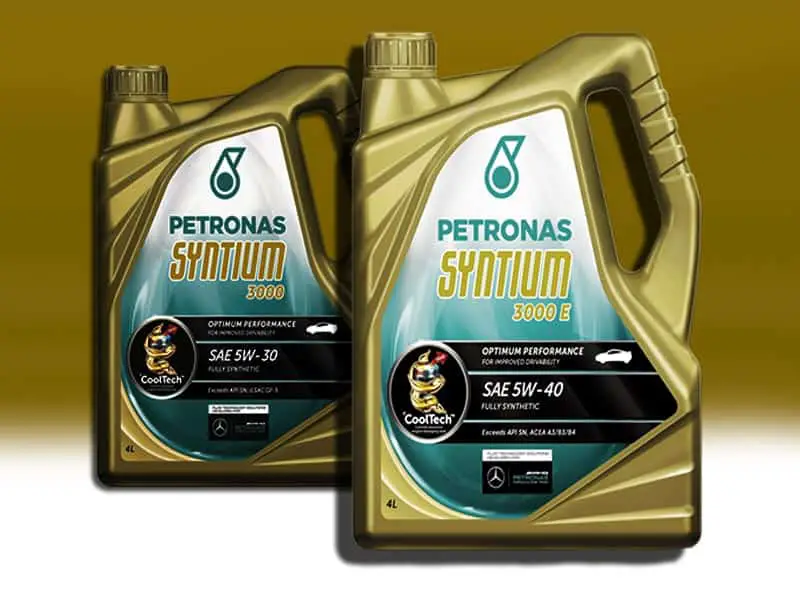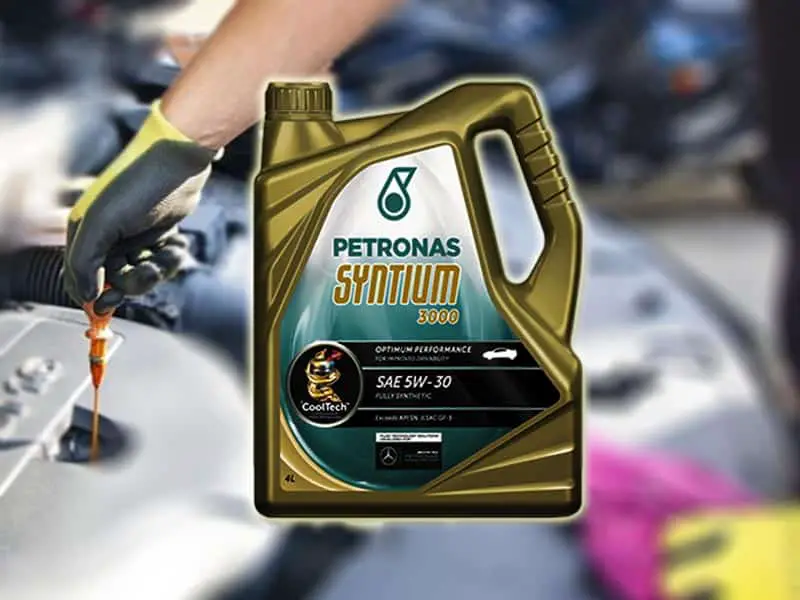Both of the engine oils are fully synthetic and formulated by using CoolTech technology to fight against excessive engine heat. They are made of group IV base oil and ingenious additives to enhance their protection abilities in extreme conditions. They meet the API SN and ILSAC GF-5 standards which means they provide better protection against low-speed pre-ignition.
There are some of the things to know about these oils which are important to know. First, the Petronas 3000 would be a better choice in high-temperature conditions since Petronas 3000E would burn off much sooner than its competitor.

2nd the oil change frequency of Petronas 3000E is comparatively lower than its competitor. Hence its fuel economy would be better.
3rd, in cold weather conditions, Petronas 3000E would be a preferable choice.
And lastly, the Petronas 3000E is costlier than its competitor.
Petronas Syntium 3000 is formulated for the latest high-performance gasoline engines. It provides ultra-protection to engines in high-temperature conditions and instant startup lubrication. It prevents oil breakdown by providing oxidation control in high-temperature conditions.

The other oil, the Syntium 3000E, is formulated for the latest high-performance gasoline and diesel engines. It provides excellent fuel economy and prevents the engines from breaking down in cold weather conditions by providing instant lubrication. Its protection against sludge and deposit is also phenomenal.

| Specifications | Petronas Syntium 3000 | Petronas Syntium 3000E |
| Oil Type | Full Synthetic | Full Synthetic |
| Engine Type | Gasoline | Gasoline / Diesel |
| Available viscosity grades | SAE 5W – 20, SAE 5W – 30, SAE 5W – 40 | SAE 5W – 30, SAE 5W – 40 |
| ILSAC | GF-5 | GF-5 |
| API | SN | SN/CF |
| Cost of 5W – 30 grade | $40.72, 4 liter | $44.21, 4 liter |
| Oil change interval | 10,000 miles | 10,000 miles |
| Additives | Anti-wear additives, Extreme Pressure Additives, Cleaning agents, Anti-oxidants, Pour point depressants | Anti-wear additives, Anti-wear additives, Cleaning agents, Anti-oxidants, Cleaning agents, Anti-oxidants, Viscosity index improvers |
| ACEA | A3 | A3/B3 |
Table of Contents
Oil Burning off your engine
At high-temperature conditions, engine oils get evaporated and burn off, depending upon two important parameters, volatility, and flashpoint. Volatility determines the evaporating tendency of any liquid at any temperature, while flash point if the temperature where the vapors would flash or ignite if provided an ignition source. The evaporation and burning off causes the deficiency of motor oil in the engine which could lead to engine failure.
3000E has low flashpoint value than 3000, which means it would burn off more quickly than its competitor. Hence in high-temperature conditions, it would be wise to choose 3000 over its competitor.
| Parameter | Petronas Syntium 3000 5W – 40 | Petronas Syntium 3000E 5W – 40 |
| Flash Point | 236 o C | 230 o C |
Minimizing Engine Wear-Off
The most commonly used anti-wear additives in engine oils are zinc, boron, and phosphorous. Their purpose is to form thick layers between moving components of the engine to reduce friction and protect them from wear. The wear that occurs in an engine could be the result of engine heat up, seal breakage, oil thinning, or even improper vehicle operation.
The concentration of anti-wear additives in both of the contenders is almost the same and hence their wear protecting ability is also equivalent. Both of them would be preferable in case you are looking for engine oils with better anti-wear abilities.
| Additive | Content in Petronas Syntium 3000 5W – 40 (ppm) | Content in Petronas Syntium 3000E 5W – 40 (ppm) |
| Zinc | 1066 | 1054 |
| Phosphorous | 937 | 949 |
| Boron | 93 | 71 |
Viscosity Comparison
The viscosity of engine oil can be defined as its resistance to flow. Three important parameters to consider while differentiating the viscosities of two engine oils are kinematic viscosity, viscosity index, and pour point. If we divide the viscosity of engine oil by its density, then the result would be kinematic viscosity. The viscosity index determines the effect of temperature change on the viscosity of a lubricant and its value is contrary to the effect. As we can see in the characteristic table given below, 3000 has more kinematic viscosity at two different temperatures. We can also see that 3000 has a comparatively high value of viscosity index as well, which means its viscosity would be less affected by temperature change.
In cold weather conditions, engine oil loses its flowing characteristic at a certain low temperature, it is known as the pour point. From the given data below, we can state that 3000E would be a better option in cold weather than its competitor since it would not lose its flowing characteristic before than 3000.
| Parameter | Petronas Syntium 3000 5W – 40 | Petronas Syntium 3000E 5W – 40 |
| Kinematic Viscosity at 40o C | 86.32 | 79.78 |
| Kinematic Viscosity at 100o C | 14.23 cSt | 13.27 cSt |
| Viscosity Index | 171 | 169 |
| Pour Point | -38o C | -40 o C |
Health of your Catalytic Converter
The most commonly used anti-wear additives in engine oils are zinc and phosphorous. But their drawback is that they produce harmful ash which affects the performance of the catalytic converter. This formation comes into existence when a small amount of engine oils seeps into the combustion chamber and burns up. The concentration of these two substances in an engine oil determines the amount of ash formation and hence effects the catalytic converter.
The concentration of zinc and phosphorous in both the contenders is same and hence their effect on catalytic converter would also be the same.
| Engine Oil | Concentration of Zinc (ppm) | Concentration of Phosphorous (ppm) |
| Petronas Syntium 3000 5W – 40 | 1066 | 937 |
| Petronas Syntium 3000E 5W – 40 | 1054 | 949 |
Sludge Build up in engines
The oxidation process occurs in an engine oil when it breaks down in high temperature and reacts with oxygen. Then it mixes with dirt, contamination, and coolant gas to form sludge and deposit in the engine which thickens the engine oil causing hindrance in its flow. Lubricant manufacturers came up with the solution of adding cleaning agents to the engine oil. The most commonly used agents are magnesium, sodium, and calcium and their concentration would determine the oil cleaning ability.
The concentration of cleaning agents in 3000E is slightly higher than its competitor which makes it a more effective engine oil against sludge and deposits.
| Additive | Content in Petronas Syntium 3000 5W – 40 (ppm) | Content in Petronas Syntium 3000E 5W – 40 (ppm) |
| Magnesium | 17 | 13 |
| Sodium | 3 | 0 |
| Calcium | 2644 | 2763 |
Oil Change Frequency
Combustion, oxidation, and other side reactions in engines cause the formation of harmful acids which could corrode the engine components. That’s why basic oil additives are being added into engine oils to neutralize the acids. Total Base Number (TBN) determines the neutralizing power of basic additives. And the more TBN a lubricant has, the longer it will last in the engine and the oil change interval would also be longer. By that definition, we can state that 3000E would last longer than its competitor since its TBN is slightly higher. Hence, the oil change frequency of 3000E would be lower than 3000.
| Parameter | Petronas Syntium 3000 5W – 40 | Petronas Syntium 3000E 5W – 40 |
| Total Base Number | 9.81 mg KOH/g | 10 mg KOH/g |